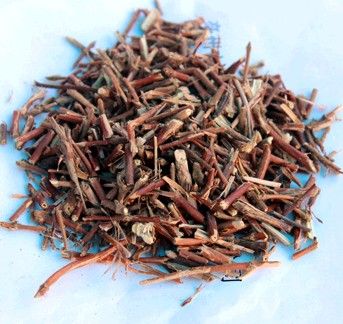Drug-based form
1. Honeysuckle perennial semi-evergreen wood vines, up to 9m. Stems hollow, many branched, young branches densely pubescent and glandular hairy. Leaves opposite; petiole 4–10 cm long, densely pubescent; leaves papery, leafy ovate, oblong-ovate or ovate-lanceolate, 2.5–8 cm long, 1–5.5 cm wide, apex short, gradual Sharp or obtuse, base rounded or subcordate, entire, pubescent on both surfaces and margins. Flowers paired to axillary, pedicels densely pubescent and glandular hairy; pedicels often solitary on upper branchlets of twigs, as long as or slightly shorter than opposite stems, 2–4 cm long at lower part, densely pubescent and glandular Hair; sepals 2, leaflike, broadly ovate or elliptic, ca. 3.5 mm, hairy or subglabrous; bracteoles ca. 1 mm, short hairs and glandular hairs; calyx short, calyx tube ca. 2mm, glabrous, 5-lobed, lobes ovate-triangular or long-triangular, apex pointed, outer and margin densely hirsute; corolla lipbaceous, 3–5 cm long, upper lip 4 lobed, corolla tube slender, outer short hairs And glandular hairs, upper lip 4 lobes obtuse at the apex, lower lip bands recurved, the flower is white at the beginning, after 2~3d change to golden yellow; stamen 5, born near the mouth of the corolla, extending out of the corolla; Pistil 1, lower ovary, style slender, extending. Berry spherical, diameter 6 ~ 7mm, mature black blue, shiny. Flowering from April to July, fruiting period from June to November.

2. The differences between the species of South China honeysuckle and Endurance Science is that young shoots, petioles, total pedicels, sepals, and small bracts are all gray-yellow curly pubescent and sparsely covered with hairs of micro glands; branchlets are red-brown or brownish. . Leaf blade ovate to ovate oblong, short hairs on both sides when young, old hairless above. Sepals lanceolate, 1–2 mm in length; bracteoles apically ciliate; calyx tube puberulent. Black fruit. Flowering from April to May, fruit ripening period of 10 months.
3. The difference between this species and the former two of the parotid honeysuckle lies in the fact that the leaves are sometimes pinkish-green, with stalks or yellow to orange mushroom-shaped glands with extremely short handles. The sepals are linear-lanceolate, nearly as long as the calyx tube, with short coarse hairs and margins on the outside; corolla white, sometimes faintly reddish, later turning golden yellow, sparsely obscured outside, often with or without Stem or glands with short stems. The fruit is sometimes white. Flowering from April to June, fruit ripening period from October to November.
4. The difference between this species and the former three species is that the young shoots, petioles, under leaves, total pedicels, sepals, small bracts, and caries are tightly curved or yellow-brown wool. Hair, hair length not more than 2mm, young branches and leaves scattered on both sides of the orange short glandular hair. Leaf blade papery, ovate oblong to oblong-lanceolate. Sepals; trichomes ovate-lanceolate; trichomes linear-lanceolate; inflorescences not adaxially basally; flowers corolla and sepals short, corolla outside densely covered with khaki fallen hairs and short glandular hairs developing. Flowering from June to July.
Plant Extract,Pure Plant Extract,Organic Plant Extract,Natural Plant Extracts
Allied Extracts Solutions , https://www.alliedbiosolutions.com